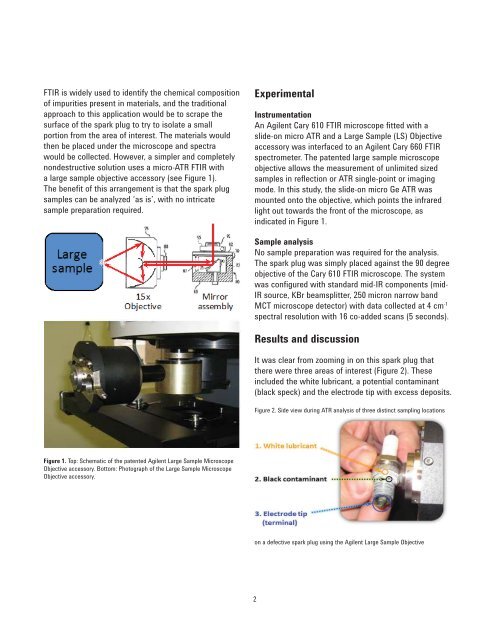Application Compendium - Agilent Technologies
Application Compendium - Agilent Technologies
Application Compendium - Agilent Technologies
You also want an ePaper? Increase the reach of your titles
YUMPU automatically turns print PDFs into web optimized ePapers that Google loves.
FTIR is widely used to identify the chemical composition<br />
of impurities present in materials, and the traditional<br />
approach to this application would be to scrape the<br />
surface of the spark plug to try to isolate a small<br />
portion from the area of interest. The materials would<br />
then be placed under the microscope and spectra<br />
would be collected. However, a simpler and completely<br />
nondestructive solution uses a micro-ATR FTIR with<br />
a large sample objective accessory (see Figure 1).<br />
The benefi t of this arrangement is that the spark plug<br />
samples can be analyzed ‘as is’, with no intricate<br />
sample preparation required.<br />
Figure 1. Top: Schematic of the patented <strong>Agilent</strong> Large Sample Microscope<br />
Objective accessory. Bottom: Photograph of the Large Sample Microscope<br />
Objective accessory.<br />
Experimental<br />
Instrumentation<br />
An <strong>Agilent</strong> Cary 610 FTIR microscope fi tted with a<br />
slide-on micro ATR and a Large Sample (LS) Objective<br />
accessory was interfaced to an <strong>Agilent</strong> Cary 660 FTIR<br />
spectrometer. The patented large sample microscope<br />
objective allows the measurement of unlimited sized<br />
samples in refl ection or ATR single-point or imaging<br />
mode. In this study, the slide-on micro Ge ATR was<br />
mounted onto the objective, which points the infrared<br />
light out towards the front of the microscope, as<br />
indicated in Figure 1.<br />
Sample analysis<br />
No sample preparation was required for the analysis.<br />
The spark plug was simply placed against the 90 degree<br />
objective of the Cary 610 FTIR microscope. The system<br />
was confi gured with standard mid-IR components (mid-<br />
IR source, KBr beamsplitter, 250 micron narrow band<br />
MCT microscope detector) with data collected at 4 cm -1<br />
spectral resolution with 16 co-added scans (5 seconds).<br />
Results and discussion<br />
It was clear from zooming in on this spark plug that<br />
there were three areas of interest (Figure 2). These<br />
included the white lubricant, a potential contaminant<br />
(black speck) and the electrode tip with excess deposits.<br />
Figure 2. Side view during ATR analysis of three distinct sampling locations<br />
on a defective spark plug using the <strong>Agilent</strong> Large Sample Objective<br />
2

















